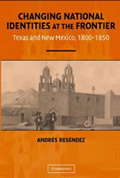Author's response
| Book: | Changing National Identities at the Frontier: Texas and New Mexico, 1800-1850by Andrés ReséndezCambridge: Cambridge University Press ISBN: 0521543193; pp. xiii + 309, 2004 |
| Reviewer: | James E. CrispNorth Carolina State University |
First of all, I can only be grateful for James E. Crisp's very generous review of my study of national loyalties along Mexico's Far North in the years leading up to the Mexican-America War. His review is both detailed and very insightful in ways that only someone deeply knowledgeable of the tumultuous history of Texas during this time could have written.
Changing National Identities receives Professor Crisp's praise in the course of the review. But he also raises one important point, namely that in the discussion of the Texas Revolution of 1835-36 the book 'fails to see the power of the market transforming itself into the power of the state'. More specifically, he notes that mercantile houses in New Orleans fanned the flames of insurrection in Texas with a clear aim to wrest this territory away from Mexico as shown by Edward L. Miller in his new book New Orleans and the Texas Revolution. (1) In a similar vein, the reviewer emphasises 'the degree to which the revolutionary Texan leader Sam Houston was a conscious agent of the United States . . . to see that President Jackson's goal of annexing Texas would come to fruition'.
These are empirical matters that I can hardly dispute and which would have undoubtedly added some nuance to the interpretations advanced in the book (unfortunately, New Orleans and the Texas Revolution came out almost simultaneously with my own book so I was unable to benefit from its insights). But there is something greater at stake here. The process through which the power of the market morphed into the power of the state lies at the core of the history of North America during the nineteenth century. After all, the economy of the United States washed over large swaths of Mexico's Far North as well Central America and the Caribbean, resulting in massive political clout in all of these areas, often presaging US military interventions and sometimes ending in temporary or permanent state control. (Indeed, something analogous occurs today as the last remaining superpower uses its enormous economic clout to affect politics and culture on a global scale.)
The entire premise of Changing National Identities at the Frontier is that the inhabitants of places like Texas and New Mexico in the early nineteenth century were torn apart by two different kinds of power: Mexican institutions like the civil administration, the church, and the army anchored the lives of these frontier men and women, pulling them south as it were, while the economy of the region inexorably gravitated toward the dynamic markets of the United States in the north. In advancing this argument I am forced to make a distinction between state power and economic power. While this makes some sense from a conceptual point of view, in real life the boundaries between these two spheres of power were exceedingly permeable. For instance, Mexican officials created attractive economic opportunities for frontier inhabitants by making legislative, judicial, or executive decisions. Conversely, Anglo-American entrepreneurs residing all along the Mexican frontier wielded real political power in everyday life in spite of protestations to the contrary. It is in this last sense that Creole mercantile houses in New Orleans chose to deploy their financial assets to promote a vision closely aligned with the national project of the United States and against that of Mexico.
In the course of Changing National Identities I drop lines here and there about the futility of dissecting the different components of power. Professor Crisp's objections make clear that I should have embarked on a more deliberate discussion of this issue. I can only conclude that the mesmerising richness of frontier revolutions like those that rocked Texas and New Mexico during the first half of the nineteenth century can only keep causing headaches to historians bent on parsimonious, overarching interpretations. Fortunately, such richness, vibrancy, and immediacy are the very traits that have long appealed to an audience that goes well beyond the narrow confines of professional historians.
August 2005
Notes
- . Edward L. Miller, New Orleans and the Texas Revolution (College Station, Texas, 2004). Back to 1.

